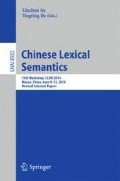Abstract
What determines the “basicness” of words still remains a challenging question in creating basic lexicons and basic wordlists. Since frequency and dispersion seem to be the most dominant criteria, it is questioned that whether contextual factors also help to define the concept of “basicness.” From the perspective of the distributional model, meanings are represented through the interaction between words and their contexts. Hence, this research aims to examine an existing wordlist and tentatively take it as the standard of “basicness,” trying to seek the differences between “basic words” and “non-basic words” based on their occurrences in different texts. Two experiments were conducted to answer the research questions. The first calculated the “latent semantic distances” between basic words and non-basic words. The second calculated and examined the “near neighbors” of basic word and non-basic words. It has been discovered that basic words tend to occur in more similar texts than non-basic words do; in addition, the near neighbors of basic words tend to be more “basic”, too. This research contributes to providing a more “contextual” perspective in exploring “basicness.”
Access this chapter
Tax calculation will be finalised at checkout
Purchases are for personal use only
Preview
Unable to display preview. Download preview PDF.
References
Barsalou, L.W.: Are there static category representations in long-term memory? Behavioral and Brain Sciences 9(04), 651–652 (1986)
Bauman, J., Culligan, B.: General service list. ms (1995). http://www.jbauman/gsl.html
Brezina, V., Gablasova, D.: Is There a Core General Vocabulary? Introducing the New General Service List. Applied Linguistics (2013)
Chang, L.: A preliminary approach to grading vocabulary and patterns of Chinese as a second language. National Science Council Research Report (NS-92-2411-H-003 -045) (2004)
Chang, L., Chen, F.: hua2yu3 ci2hui4 fen1ji2 chu1tan4. (On Chinese Lexicon Levels). The Sixth Chinese Lexical Semantics Workshop Proceedings (2005). (in Chinese)
Chang, L.: dui4ying4 yu2 ou1zhou gong4tong2 jia4gou4 de hua2yu3 ci2hui4 liang4 (On Structuring Chinese Lexicon). Chinese Teaching Research 9(2), 77–96 (2012). (in Chinese)
Chen, M.-L., et al.: The construction and validation of Chinese semantic space by using latent semantic analysis. Chinese Journal of Psychology 51(4), 415–435 (2009)
Coxhead, A.: A new academic word list. TESOL Quarterly 34(2), 213–238 (2000)
Dumais, S.T.: Latent semantic analysis. Annual Review of Information Science and Technology 38(1), 188–230 (2004)
Firth, J.R.: Studies in linguistic analysis. Basil Blackwell, Oxford (1957)
Wild, F.: lsa: Latent Semantic Analysis. R package version 0.63-3 (2011). http://CRAN.R-project.org/package=lsa
Harris, Z.S.: Distributional structure. Springer (1981)
Kintsch, W., Mangalath, P.: The construction of meaning. Topics in Cognitive Science 3(2), 346–370 (2011)
Landauer, T.K., Foltz, P.W., Laham, D.: Introduction to Latent Semantic Analysis. Discourse Processes 25, 259–284 (1998)
National Chinese Teaching Leading Group: Han4yu3 shui3ping2 kao3ci4 hui4yu4 han4zi4 deng3ji2 da4gang1 (The Introduction of Chinese Language Test). Beijing Linguistics Department Published, Beijing (1992). (in Chinese)
Quesada, J.: Creating your own LSA spaces. In: Landauer, T.K., McNamara, D.S., Dennis, S., Kintsch, W. (eds.) Handbook of Latent Semantic Analysis, pp. 71–88. Mahwah, Erlbaum (2007)
Sinica Academia Corpus Study Group: Lexical Frequency Dictionary. Sinica Academia Chinese Database Group Technical Report CKIP-98-01. Sinica Academia, Taipei (1998a)
Turney, D.P., Pantel, P.: From frequency to meanings: Vector space models of semantics. Journal of Artificial Intelligence Research 37, 141–188
Vossen, P., et al.: The eurowordnet base concepts and top ontology. Deliverable D-017, D-34, D-036 (1998)
Vossen, P. (ed.): EuroWordNet general document. Technical report. University of Amsterdam, Amsterdam, Version 3, Final, July 1 2002
Author information
Authors and Affiliations
Corresponding author
Editor information
Editors and Affiliations
Rights and permissions
Copyright information
© 2014 Springer International Publishing Switzerland
About this paper
Cite this paper
Lin, S.YH., Hsieh, SK. (2014). Latent Semantic Distance Between Chinese Basic Words and Non-basic Words. In: Su, X., He, T. (eds) Chinese Lexical Semantics. CLSW 2014. Lecture Notes in Computer Science(), vol 8922. Springer, Cham. https://doi.org/10.1007/978-3-319-14331-6_27
Download citation
DOI: https://doi.org/10.1007/978-3-319-14331-6_27
Published:
Publisher Name: Springer, Cham
Print ISBN: 978-3-319-14330-9
Online ISBN: 978-3-319-14331-6
eBook Packages: Computer ScienceComputer Science (R0)

